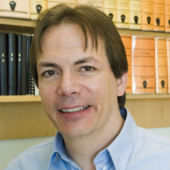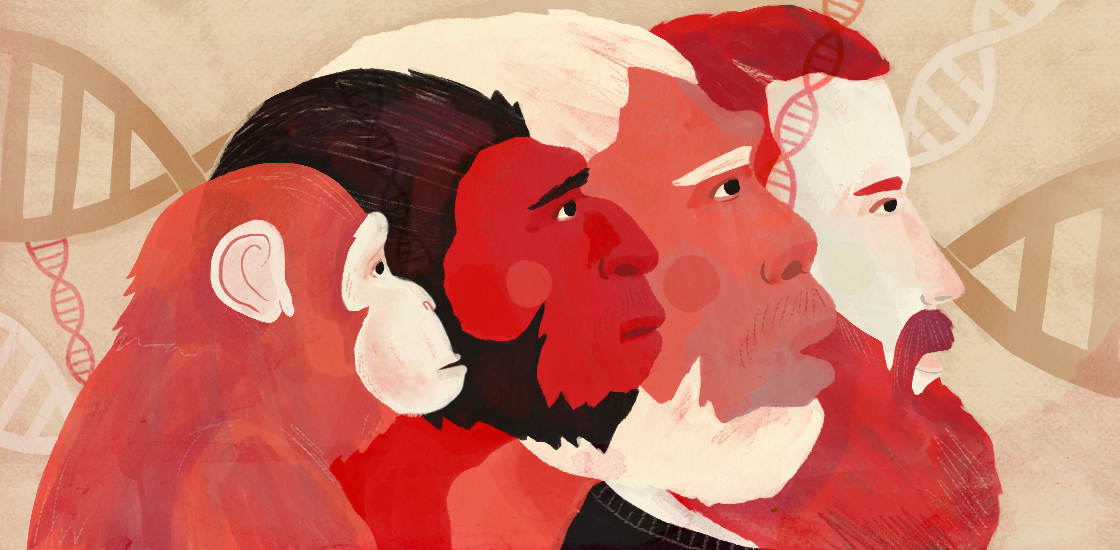THIS ARTICLE IS MORE THAN FIVE YEARS OLD
This article is more than five years old. Autism research — and science in general — is constantly evolving, so older articles may contain information or theories that have been reevaluated since their original publication date.

Since graduate school, Evan Eichler has been drawn to the genetic differences that distinguish humans from our closest ancestors. These differences make us unique — cognitively, socially and linguistically, he says.
In the 3 August issue of Nature, Eichler and his colleagues reported that humans — but not their ancestors — are prone to a DNA deletion or duplication tied to autism1. This susceptibility arises from extra copies of a single gene, and the persistence of these gene repeats raises the possibility that the gene gives people an evolutionary advantage.
We spoke with Eichler, professor of genome sciences at the University of Washington, about the implications of this finding and what he hopes to learn about autism by looking back in time.
Spectrum: Why did you decide to look for DNA that makes humans unique?
Evan Eichler: I’ve always been struck by the observation that the genetic differences in the protein-coding portion of the genome are insufficient to account for all the differences between humans and our primate relatives. When I was in graduate school, I started looking at areas of the genome that contain repeated sequences. When these sequences bracket a stretch of DNA, they make this region unstable and prone to deletion or duplication.
Over the past 10 years, we have identified about 20 of these so-called copy number variants (CNVs) that can lead to intellectual disability, developmental delay and autism. I started to realize that the DNA repeats that promote these structural mutations are more common in our species than in any other.
I also began to appreciate that these repeats are creating completely new genes: There are genes made up of pieces of the genome that never would have been brought together if it weren’t for these repeats. That led me to wonder whether the disadvantage of having this instability in our genome is offset by an advantage from these newly minted genes.
It’s been a 20-year hunt for these new genes in the ‘dark matter’ portions of the human genome — those that evade sequencing technology because of their dynamic nature.
S: What genes have you and others found?
EE: One is the SRGAP2C gene, which evolved 2 to 3 million years ago — probably around the time that Homo emerged as a genus2. The gene seems to increase the density of neuronal connections and may help to boost human brain power. The SRGAP2C gene is also near the 1q21 region, which is deleted in some people who have autism or intellectual disability.
Another set of repeats created a gene called ArhGAP11B3. This gene emerged right after we separated from chimpanzees and may have increased the number of neurons in the brain’s cerebral cortex. The repeats associated with ArhGAP11B also raise the chances of a deletion of the 15q13.3 region, which can lead to epilepsy, schizophrenia and intellectual disability.
A third example is the BOLA2 gene, which is the subject of our Nature paper. Humans have between three and nine copies of this gene, compared with the ordinary two copies in chimps, Denisovans and Neanderthals. These extra copies of BOLA2 flank the 16p11.2 region, which is duplicated or deleted in roughly 1 percent of people with autism.
This repeat cropped up more recently than any other we have seen: Many of the other repeats are millions of years old, but this one appeared roughly 282,000 years ago, after the separation of humans from Denisovans and Neanderthals.
S: Do extra copies of BOLA2 confer an evolutionary advantage?
EE: Once the BOLA2 gene duplicated, these repeats expanded rapidly in evolutionary time, and became fixed: Not a single person we tested has only two copies of the gene, and 99 percent of people have four or more copies. Based on our evolutionary modeling, without some positive selection we could never get the duplication to rise to this frequency. Everything is pointing to the fact that this architecture has conferred some type of advantage to the human species.
At the same time, it predisposed us to the second most common cause of autism in the human population: the 16p11.2 CNV. When we looked at people with 16p11.2 duplications or deletions, we found that 96 percent of these variants originate from the BOLA2 repeats.
Individuals with 16p11.2 deletions tend not to have children, so the advantage of having extra copies of BOLA2 would have to counteract its tendency to create a deletion that carries an evolutionary disadvantage.
S: What advantage might BOLA2 give humans?
EE: We speculate that it’s kind of the ‘iron-man gene.’ Its protein seems to bind to a protein in the cell that captures iron, making that protein more stable and more likely to hold on to its iron store.
Extra copies of BOLA2 may make our cells more efficient, improving metabolism. Or they could make the cells more robust under conditions of oxidative stress, which happen under rapid cell division during early development. Another theory is that the gene works to protect humans from viral infection: Iron is the life blood of viruses, but if your cells are sucking up iron faster than the viruses can retrieve it, maybe you win in the scavenging process.
We’ve now identified some people who have seven or more copies of BOLA2. And we have data that show that more BOLA2 gene copies equates to more protein in the cell. We plan to look for differences between these individuals and those who have lower levels.
S: What role might the BOLA2 gene play in autism?
EE: When the 16p11.2 region is deleted, this takes out a copy of BOLA2. We don’t think that the loss of this gene copy is causing autism. It’s more likely that the loss or gain of the 25 genes in the 16p11.2 region confers the risk. But it’s possible that having fewer copies of BOLA2 could worsen the effect of the 16p11.2 deletion in some carriers.
We’ve been looking across individuals with 16p11.2 deletions to see how many copies of BOLA2 remain. We have identified eight individuals who have only three copies of BOLA2. (Even people who have lost a copy of BOLA2 retain at least three copies of the gene.) Four of these people have anemia, or require significant iron supplementation. It’s possible that giving iron to certain children with the 16p11.2 deletions early in life would improve their outcome.

By joining the discussion, you agree to our privacy policy.